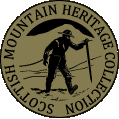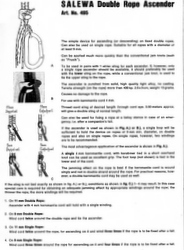
The Scottish Mountain Heritage Collection
Objects Database
Homemade Rope Ascenders/Prussiks
Accession Number
1249.2015.1
Object Name
Homemade Rope Ascenders/Prussiks
Created
19/05/2015
Creator
Hermione Cooper
Accession Date
19/05/2015
Brief Description
Two homemade ascenders on cord
Materials
aluminium alloy
Dimensions
4(l) x 3.5(w) x1(d) cms
Number Of Objects
2
Colour
silver
Provenance
These little fellas are a wee bit of an enigma since we don't really know what to call them and we are not 100% sure if we have the way they connect to the rope correct - see opposite, so this item comes with a government health warning!
We do know that mountaineers have been climbing ropes, as well as mountains, since the sport began - sailors and cavers too. Back in the old days they used a friction knot known as a 'prussik' and many still do since it's simple, efficient and pretty foolproof, albeit rather slow and tedious.
As is often the way, an easier way is often sought and we now have a vast array of mechanical devices for climbing ropes and even an industry that specialises in such antics. Industrial Rope Access Trade Association (IRATA)
Somewhere along the way (circa 1970) the German company, Salewa, produced a little piece of aluminium - see opposite - which we can only assume was designed to speed up the process of tying a prussik, particularly in a crevasse rescue situation.
Sometime after that, pioneer Scottish climber and prolific gear maker, Bill Skidmore, decided to make his own and we are delighted to have both versions in the collection. Very few of these devices have survived and we suspect that's because they were not much use and like us, folk were not quite sure what to do with them!
Acquisition Method
Donated by Mary Henery
Acquisition Date
19/05/2015
Condition Check Date
19/05/2015
Rules
Spectrum : UK Museum documentation standard, V.3.1 2007
Modified
19/05/2015

